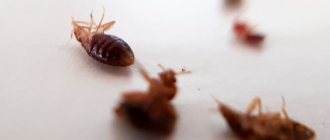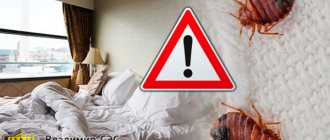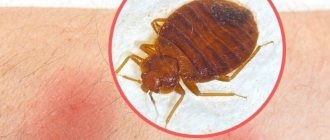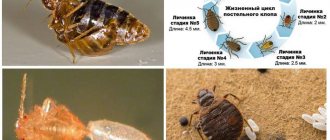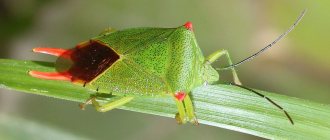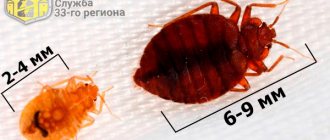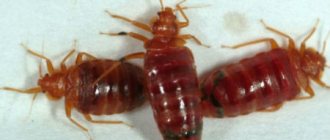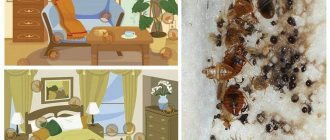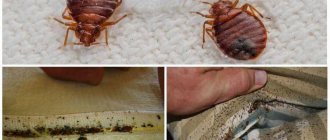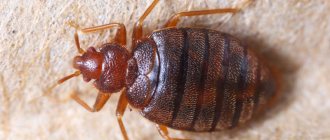Bedbugs are currently one of the most important problems of modern society, and for many city residents they are an inevitable, expensive and painful problem. In Russia, bed bug infestation in city apartments is worsening every day, so it is not surprising that in the regions of the country this is a fairly common phenomenon.
And in New York, the parasite infestation is considered a full-blown epidemic. It's so bad that at the beginning of the year a summit was held to combat bed bugs in city apartments. Blood-sucking bugs will not destroy you, but they can drive you crazy (they affect the human psyche): it is impossible to sleep in your own apartment, cozy houses turn into dangerous places, the night is terrifying and many victims of bed bugs cannot get rid of the fear of parasites.
Bed bugs reproduce at an incredibly fast rate. One female can lay from 4 to 10 larvae per day and approximately 500 eggs over the entire period of life, and her relatives can reproduce themselves within a month. In a week, these insects are able to inhabit a 2-room apartment, in a month, the 1st floor of an apartment building, and in six months, a 5-story panel building.
Habitats and breeding places for bedbugs in an apartment
Once in a new place, house bugs very quickly begin to settle in and reproduce. As a rule, for permanent residence these “neighbors” choose places that are difficult to access and inconspicuous for humans. However, not everything is as scary as it might seem at first glance; a colony of domestic bugs can be detected if you know the main areas of their accumulation.
1. First of all, what you should pay attention to are sleeping places (bed, sofa, sofa, crib, etc.), since domestic bugs mainly feed on human blood, it is much more convenient and easier for them to settle near the source food, that is, with our body. You need to carefully inspect the bed frame, the seams of the mattresses, under the mattress, you may find black spots (excrement) of insects, remains of eggs, or bed bugs themselves. You may also find bloody stains on your bed linen.
2. Look behind paintings, behind carpets, rugs and shelves; you can also find bedbugs or traces of their habitat there, especially if they are located near a person’s place of rest at night.
3. Carefully inspect corners, floor crevices, baseboards, under nightstands, beds and cabinets. Take a broom and dustpan, walk through these places, if you find black dots and insect skins in the garbage, then this is an alarm bell, you have bedbugs.
4. Sockets, another favorite place for house bugs, the heat that electricity produces, as well as the seclusion of the place, makes these parasites comfortable to stay. Under no circumstances try to lure them out of there yourself.
5. Wardrobes, chests of drawers, clothes, books and bookshelves; bedbugs can hide in all these secluded places. Don’t be lazy and inspect the joints of doors, under the window sill, and the folds of curtains.
6. In places where the wallpaper comes away from the walls, bedbugs can also build their “nest”, hiding from the human eye during the daytime. They can be easily detected by simply knocking on the walls.
7. “Our smaller brothers”, they are also susceptible to attack by bedbugs. If you begin to notice that your pet is often itching and suffering from bites, then it is quite possible that this is the work of domestic bugs. Carefully inspect your pet's cage, tray, and sleeping place.
House bugs in an apartment, like any other insects, leave traces characteristic of them, which can be used to detect places of their accumulation and reproduction, as well as to determine the population size. These simple tips will help you in the fight against “bloodsuckers”, and remember, the sooner resistance begins, the easier it will be to clear your home of these unwanted guests.
External data and characteristics of the parasite
The linen bug differs from midges and other species of its own kind by its inability to fly. Born to crawl and suck the blood of living things, it has a clearly segmented abdomen. If you look closely, it seems as if his entire miniature body is tied with shiny belts and divided into striped segments.
- Head. Has the shape of a triangle. Below there is a long proboscis, which is essentially jaws fused together. True, all this can be seen only under a microscope. The proboscis is sharp enough to pierce human skin. But it cannot pierce the skin of cattle or dogs of large and medium breeds.
- Length. The body length of a hungry insect does not exceed 3 mm. However, as it becomes saturated, the body stretches and lengthens. After gorging themselves, bed bugs reach more impressive sizes - up to 8 mm.
- Form. When hungry, bed bugs look like a flattened cake. But the insect, which has managed to feed on the blood of its victim, noticeably rounds, stretches, turning into a tiny barrel.
- Color. The shell is brown or red-brown with a brown tint. And here, too, everything depends on the satiety of the creature. A hungry bug is lighter than its well-fed counterparts, but after a meal it also takes on a deep dark shade.
The parasite's proboscis has two separate valves. One is designed to absorb blood, and the second is to introduce an analgesic, a substance that relieves pain, into a hole made in the skin, allowing the insect to strike the victim as unnoticed as possible.
Features of life
The life cycle of a bed bug is quite monotonous and lasts on average 12 months. Particularly tenacious representatives of the species live for a year and three months.
- Pairing. A female may have only one mating process in her life. The male “transplants” his seed into the chosen one in a traumatic way. In fact, he pierces her abdomen with his genitals to share genetic material. The female periodically lays eggs if she considers the surrounding conditions favorable for “children.” On average, she lays up to five hundred eggs during her life.
- Transformation of an egg into a nymph. After a week or two, the egg turns into a nymph, that is, into a larva. The next transformation will occur only when the nymph drinks a full portion of human blood. Compare: the female drinks 7 ml of “food” in one sitting, and the nymph drinks no more than 0.3 mg.
- Incubation period. Depending on conditions, the transformation of an egg into a mature individual takes from a month to 100 days.
- Period of suspended animation. Bed bugs feed on human blood. Sometimes - the blood of bats and domestic animals (those whose skin can be bitten through). If an insect remains hungry for a long time, it goes into hibernation - suspended animation. Bed bugs can live without food for up to a year. But as soon as food begins to loom on the horizon, they immediately awaken from sleep and begin to act instantly.
At a temperature of 50 °C, bed bugs die. And instantly. These creatures are more resistant to frost than to heat. For an egg to die, the air temperature in its habitat must remain at –30 °C for at least two to three days.
Differences from other insects
Due to ignorance, the bedbug can easily be confused with other insects. For example, with ants, which nymphs (parasite larvae) look like, or with fleas. Four main differences will help you get to the bottom of the truth.
- Lack of wings. If an insect has wings, it is most likely a cockroach. Or, alternatively, any other insect that has entered the house from the street.
- Inability to jump. A miniature bug that dashingly jumps from object to object is a flea. A real laundry parasite can neither jump nor fly. In his arsenal of talents there is only prosaic crawling.
- No constrictions in the abdominal area. If the insect you find has such a constriction, then it is an ant.
- The presence of six legs. Flat, round, small bugs with eight legs are mites. They are extremely dangerous, but they do not settle in human habitation and do not form nests in sofas.
Bedbugs are often confused with cockroach larvae. However, the latter have a characteristic difference - a double tail (a bifurcation in the lower part of the abdomen). Biting parasites have nothing like this.
How to determine if there are bedbugs in the house? Signs of bedbugs in an apartment
The house bug, a small insect, appears mainly at night, and the pest can be detected almost only by accident. Often we discover their appearance in our apartment when their numbers have already increased. determine whether bedbugs have settled in an apartment , but there are several simple and effective ways to recognize the presence of a homebug.
• If you wake up and see swelling and redness on your body, you should know that you were obviously bitten at night. Bites are the first sign that you have bedbugs. Many people, perplexed, attribute such bites to mosquitoes, especially those who were bitten for the first time, but in vain, there are still differences. When mosquitoes bite, they produce an enzyme that promotes blood clotting, but bedbugs do not have such an enzyme, so a drop of dried blood will be visible at the site of the bite. If the redness is located in the form of random paths, then you have definitely been fed by a bug. Itching, burning, and, in rare cases, allergic reactions, all these can be signs of bedbug bites.
• The appearance of bloody, brown marks on the bed linen is another signal that uninvited guests have come to you, this is due to the incoagulability of blood during a bite, but this is not a direct sign of the appearance of bedbugs in your apartment, the origin of such stains may be different.
• Another proven way to detect a house bug, get up at night, the peak of insect activity occurs at 5-6 in the morning, turn on the light, inspect the bed, if your apartment is infested, then one bug will come to your bed.
• Bedbugs have the ability to shed skins (exoskeletons). If during cleaning you find dried insect shells, this may also indicate that “bloodsuckers” live in the room; you can also find them along with black dots and white larvae in the upholstery of upholstered furniture, mattresses, and books.
• Smell, bedbugs emit a specific smell, reminiscent of the smell of spoiled raspberries, or cognac, if you smell such a “scent” in your apartment, it means that the population is very high, the apartment is quite heavily infested.
Bites, black dots (excrement), white larvae and keratinized membranes are all signs that your home has been infested by bedbugs, and of course the most obvious sign is the detection of the insect itself. If at least one of these indicators is detected, measures should be taken immediately to combat parasites. Even if you haven’t found a large outbreak of infection in your apartment, don’t put things off, start the war right now!
How dangerous are bites?
These blood-sucking parasites are not known to transmit infections or life-threatening diseases . Nevertheless, their bites cannot be ignored.
Externally, they differ from mosquitoes in that they look like a path of several punctures. They:
- cause itching and irritation on the skin;
- lead to nervousness and lack of sleep;
- affect the psychological state;
- reduce performance;
- provoke allergies.
Scratching bites can lead to pustules. In rare cases, if a child is regularly bitten by bedbugs, there is a risk of developing iron deficiency anemia.
We also bring to your attention useful information about bites from fleas, cockroaches, and ants. Find out why cockroaches are dangerous to humans and what diseases fleas carry.
Where do bedbugs come from in an apartment? Routes of entry
Unfortunately, none of us are immune from the appearance of bedbugs in our apartments. There is an opinion that bedbugs live only in dirty, unsanitary rooms; this is far from true; they can inhabit absolutely any apartment. Even if you do a thorough cleaning of your home every day, these “guests” can come to you at any time, or you can bring them into your home yourself.
So where do bed bugs come from? This question is asked by most people who have suffered such a misfortune. There are several common options for the appearance of domestic bedbugs.
- No matter how strange and ridiculous it may sound, it is really possible. Without knowing it, you can bring a bug into your home in a new, just purchased sofa or mattress, in clothes, or in a soft toy. This can happen if the store you shop at is infested with these insects.
— When going on a trip or a business trip, be careful, you can easily “pick up” a bedbug on trains; they can hide behind shelves or in the upholstery of a mattress. In a hotel, especially cheap motels, in a rented apartment, carefully inspect your bags, suitcases, and clothes before returning home.
— House bugs can also come to you from your neighbors. This may be their natural migration, since bedbugs like to travel from apartment to apartment looking for a source of food. Also, if the neighbors left their home for a long time, thereby depriving the bug of food, then the insects will begin to move into the apartment next door. If you smell chemicals, or find out that parasites are being poisoned nearby, then be prepared to meet uninvited “guests”. A bedbug only needs a small gap in the wall, floor, or ceiling to enter your home.
— Your friends, acquaintances, relatives, whose apartment is infested with insects, can also bring a bedbug into your home when they come to visit you. It is possible that, having been in such a house, you will bring yourself a parasite in your belongings or clothes. Bedbugs in the apartment
may remain from the previous owners or tenants of the premises. Hospitals and kindergartens, health camps and sanatoriums, these places can also be infested with bedbugs.
Remember that the bug is a synanthropic arthropod, that is, individuals live in residential premises, populated areas, and on the human body. Bed bugs do not like to remain without food for a long time, so they travel with humans. They are able to cover long distances in a short time. The appearance of a domestic bug in an apartment is fraught with various troubles, such as sleepless nights, nervous shock, bites, rashes, allergic reactions; it has also been established that pathogens of diseases such as the hepatitis B virus, typhoid, Q fever can remain in the insect’s body.
Shield insects
Shield bugs are a large family of bugs. You can meet them almost anywhere: in the courtyard of a house, on a personal plot, in the forest, in a field, in a park, in flower beds. Bedbugs are called stink bugs because of the shape of their body. If you look at it from above, it looks like an irregular pentagon. All representatives of the genus of stink bugs are characterized by specific secretions from odorous glands, which play the role of pheromones and a deterrent for enemies. Because of this, they received an offensive nickname: stink bugs.
Shield insects
It is not typical for the stink bug species to attack humans. For the most part, they feed on plant juices, and in rare cases, the remains of dead insects.
About 70 species of shield insects are found in Europe.
Self-extermination of bedbugs at home
Currently, quite a lot of people are faced with the problem of house bugs and are looking for the most effective ways to destroy them. You need to start pest control of bedbugs as soon as you find them in your apartment, don’t put it off “until tomorrow,” because these insects reproduce very quickly; a female bedbug can lay 5-7 eggs a day. Therefore, you should not hope that bedbugs will leave your home on their own; you need to start disinfesting your home yourself as soon as possible. Let's look at several basic methods for disinfesting bedbugs at home.
Home Remedies
It is worth noting here that the use of improvised means is not a sufficiently effective way to combat bedbugs. These methods can be used, for example, to temporarily get rid of insects, as well as if the population size is very small.
— For the disinfestation of bedbugs, a method such as evaporation is used. Insect habitats must be doused with boiling water or treated with steam. At high temperatures, above 48ºC, bedbugs die. You also need to wash your linens and clothes.
— You can walk around the apartment with a vacuum cleaner, thoroughly vacuuming the upholstery, bed, corners and crevices. But bedbugs often hide in secluded, hard-to-reach places where you simply cannot reach them with a vacuum cleaner.
— Bedbugs cannot stand the smell of fresh Wormwood, so it is placed under the bed and in areas where insects live. You can also mix a solution of table vinegar and turpentine in equal proportions and spray the areas where bedbugs accumulate with a spray bottle.
Modern chemicals
For more effective pest control of house bugs, it is best to use chemicals specifically designed to combat parasites. Although home remedies can bring results, they are usually temporary; to completely eliminate bedbugs, modern chemicals should be used. Currently, there are many products on the market for disinsection of bed bugs. Let's look at several of the most effective modern chemical insecticides.
— The drug “Delta Zone”, a microencapsulated product, is effective against domestic bugs; the poison contained in the microcapsule penetrates the intestines and envelops the body of the insect, thereby killing not only the “parasite” itself, but also infecting its relatives. A distinctive property of this drug is its absolute safety for people and animals, it is non-toxic, odorless, and does not leave streaks or marks.
— “Avalon”, a sharp insecticidal chemistry, perfectly deals with pests such as house bugs, cockroaches, flies, ticks and fleas. The product belongs to class 3 of moderately hazardous substances, so it only kills insects. During processing, be sure to take care of chemical protection: respirator, gloves, suit, spray bottle. Does not leave marks or stains on the treated surface.
— “Tsifoks”, another remedy that is no less effective. Contains cypermethrin at a concentration of 25%. It has a powerful effect on house bugs from the first minutes after using the drug. It has a subtle odor, but it disappears as soon as the solution is ready for application. After treatment it does not leave streaks or stains.
— A Spanish-made drug “Xulat”, it contains three active ingredients: cypermethrin 10%, tetramethrin 2.2%, piperonyl butoxide 10%. What makes it a truly effective remedy against bedbugs. Also, the drug is absolutely safe for people and animals, odorless and non-toxic.
— The South Korean drug “Lambda Zone” has also proven itself as an effective remedy against insects. The new patented drug was created using a unique technology: lambda-cyhalothrin insecticide at a concentration of 2.5%, which is contained inside a nano capsule; insects are completely enveloped in this poison and die one after another. The product is safe for humans and animals, just like regular water.
— “Get,” a Russian-made product created using European technology, is a microencapsulated suspension. Contains chlorpyrifos as an active ingredient - 5%, effectively fights not only bedbugs, but also cockroaches, fleas, ticks, ants and flies. “Get”, safe for animals and people, does not leave stains.
Before disinfestation with chemicals, especially with sharp insecticides, be sure to follow protective measures, wear gloves, a respirator and closed clothing, remove utensils, food products and personal hygiene items. Read the instructions carefully and follow the correct proportions of dilution of chemicals.
Remember that the effectiveness of the drugs depends greatly on how carefully and conscientiously you treat the room. Apply the product thoroughly to each square. meter of your apartment.
If the number of insects is large enough and you cannot cope on your own, all your attempts are in vain, do not waste your energy and money. Contact specialists, call a pest control service. Currently, extermination services use modern control methods, such as a cold fog generator and a hot fog generator to kill house bugs. They will quickly and professionally treat your apartment, and you will forget about insects for a long time.
Waste products
Bedbugs leave quite a lot of marks. They shed particles of chitin and leave excrement in their habitats. They look like tiny dark brown balls. There are always a lot of them, so they can be detected easily, without the use of specialized equipment. Bedbugs hide and leave behind their waste products:
- in cracks and cracks in walls and floors;
- under the bed, sofa or closet;
- inside furniture;
- under the upholstery of upholstered furniture;
- under the wallpaper.
In addition to feces, translucent chitinous pieces can be seen. These are parts of the shell that the larva sheds when turning into an adult. Chitin particles can be found in any part of the room.
Protecting your apartment from bed bugs
No one is immune from the appearance of such unpleasant insects as house bugs. But if you try to follow the simple, most effective tips, you can protect your home from bed bug infestations.
— When planning a trip, do not choose the cheapest hotels possible, always inspect the bed and mattresses, and if you find insects, ask to change your room. When you return home, inspect all your belongings.
— If you know that friends or relatives have bedbugs in their apartment, try not to visit this house until they are completely destroyed. If this cannot be avoided, then when you come into an infected room, put your outerwear and bags in sealed bags, put on shoe covers, and better yet, do not take off your shoes.
— If you spent the night in an apartment infested with bedbugs, then upon arriving home, immediately take off all your clothes and pack them in a bag. Wash everything at a high temperature of 48ºC, then iron.
— Never bring into your home furniture found on the street or in the entrance; it may have been thrown away precisely because there were bedbugs in it.
- If bedbugs get to you from your neighbors, you definitely need to fight together, you don’t need to be afraid or embarrassed. Well, if an agreement did not work out, then systematic treatment of the apartment will be required every time insects appear.
— To significantly protect your apartment from “neighborhood” bedbugs, try to isolate the room as much as possible. Seal all the cracks on the floor and ceiling, replace the old wallpaper with new ones, install a fine mesh for ventilation, replace ordinary sockets with sockets with protective covers.
— If there is a large infestation of apartments, call a specialized pest control service as soon as possible to treat the entire house.
Answers to popular questions
If signs indicate the presence of bedbugs, it is worth considering where the parasites hide during the day.
They can hide in the most unexpected places:
- furniture.
- Appliances.
- Paintings.
- Wallpaper coming off the wall.
- Balcony.
- Etc.
It is almost impossible to determine exactly how many nests bedbugs can have in one area. Bloodsuckers choose secluded places for their settlement, closer to humans. After a night “hunt,” the parasites can sit out for up to 2 weeks until hunger forces them to crawl out again.
Where do bed bugs come from?
The invasion of bloodsuckers is due to a number of factors.
Here they are:
- Uncleanliness of housemates. Since bloodsuckers easily move through the ventilation shaft, they can start in anyone.
- Recent visit to a warm country. The favorable climate promotes year-round breeding of insects. If the female has managed to lay larvae between the folds of her resort outfits, it is very easy to acquire uninvited guests upon arrival at her home.
- Buying furniture secondhand. If you do not disinfest your recent acquisition, it is likely that parasites will appear.
Parasites can even settle in household appliances, since their regular use creates a comfortable temperature for them.
Sometimes even pets carry bed bloodsuckers, but this is an extremely rare occurrence.
Please note: self-extermination of insects using folk remedies often forces them to migrate to their immediate neighbors. If you call a specialist to treat the premises, bedbugs have no chance of survival.
Sexual dimorphism
The number of male and female individuals in the clutch is almost the same. At the nymph stage, it is impossible to determine the sex of insects. Only after the fifth molt does the sex become clear. How to distinguish a female bedbug from a male? Sexual dimorphism is manifested in the structure of the abdomen. In females it is round and wide, in males it is elongated and pointed at the end. In males, the edge of the abdomen is asymmetrical due to the presence of a copulatory organ. Female bedbugs are larger in size, they are more active and voracious, drinking about 7 ml of blood. Nutrition is necessary for the maturation of the eggs carried by the female.
Information. One fertilized female can give birth to an entire colony of parasites.
Varieties
Nature itself, and then scientists, divided these insects into three types: beneficial, harmful and harmless. There are other qualifications:
- Parasitic species feed only on the blood of animals.
- Herbivores enjoy drinking plant juice. Among them there are also pests that destroy grain crops.
- Cruciferous vegetables will harm cabbage, radishes, and radishes in the garden.
- Berries prefer to settle among plantings of raspberries, currants, and gooseberries.
- Aquatic representatives live in reservoirs. They are considered the largest among bedbugs. They feed on small fish and hunt frogs and snails.
What to do
To carry out self-treatment you will need pesticides and protective equipment, and a flashlight. Chemicals, gloves, masks and disposable gowns can be purchased in specialized stores. A garden sprayer is suitable for spraying the product. Detected bedbugs can be collected with a vacuum cleaner. Treat infected seams with a steam generator. Places where bedbugs enter the room can be treated with gels (barrier treatment).
The collected bedding must be boiled in hot water.
To make your task easier, it is advisable to call a professional disinfector, whose tasks include not only destruction, but also search and identification of all colonies. Including cockroaches, fleas, ants. They know where to look and the easiest way to find them. And also by what means can they be killed as completely as possible. Even if some individuals remain after professional treatment, they die from the residual effects of the drugs.
Plan of mandatory activities carried out by specialists:
- a thorough examination of the entire premises, including finishing;
- determination of the degree of infestation;
- selection of effective means.
The exterminator will save time and will most likely remove bedbugs the first time. There is no need to delay treatment if bedbugs have already been found. The sooner pest control work begins, the faster, easier and cheaper it will be to get rid of them.
After carrying out the treatment yourself or with the help of a specialist, you need to take preventive measures. Start by blocking entry points into the room. Insulate sockets with polyurethane foam and install plugs. Ventilation shafts should be equipped with fine mesh. Repair cracks in the floor, ceiling and walls using sealant.
Regular examinations should be carried out during the first months. After some time, carry out additional barrier treatment.
